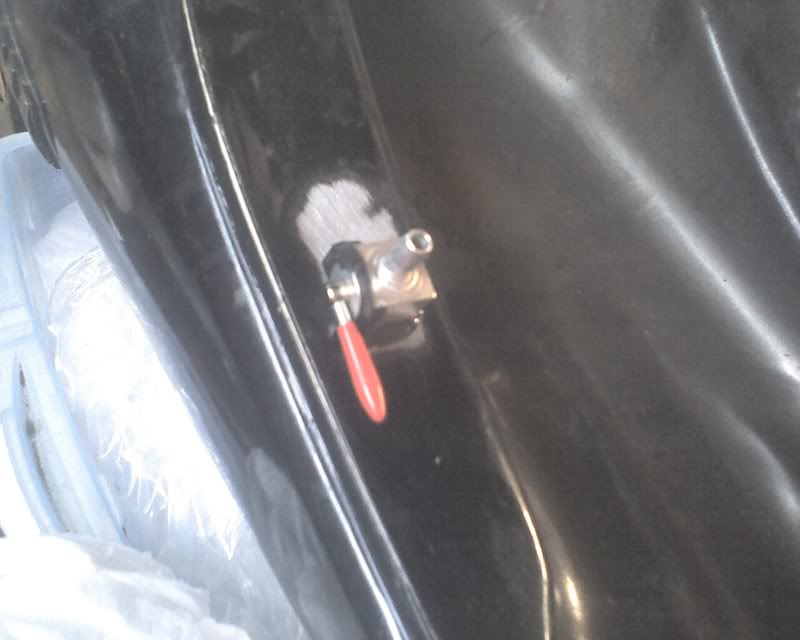Monday fighter practice was canceled due to rain, so I got to play Buzz on Monday afterall…
I elected to use the stock coils on EDIS, at least for the time being. With the stock ignitor module removed, I could not seem to isolate the coils from ground. They are 3 ohm coils, but I kept seeing about 10 ohms to ground. Later analysis of the wiring diagram seems to indicate that there is a relay coil on the common power lead, so this may not be such a bad thing. I will more carefully check it out, for as it stands right now, the kill switch and the kickstand safety interlock are inoperable and I’d rather they weren’t.
So, before I figured all that out, it was a simple enough matter to wire spade lugs to leads and run the leads from the EDIS to the coil pigtails under the tank. I connectorized most of the module wiring. I used a 3 pin connector for the coils and a 2 pin for the connection to MegaSquirt. The stock VR coil is connected by spade lugs; long term, I may do that differently. The module ground is on a ring under the same engine block block as the main ground and is the only wire without some form of quick disconnect.
For power, I needed another main relay power source for the module and coils, but I didn’t want to tear into rewiring the fuse block. What I did in the short term was move the FIDLE power and fuse to the spare from the fuel pump relay and put the EDIS power to the former FIDLE circuit on the main relay, with a 15A fuse. This means that the FIDLE light only lights when the fuel pump relay is energized, when the engine is running or during the pressure-up interval when the ignition key is first turned on. I don’t expect that to be an issue, even if I do manage to get FIDLE working with a proper solenoid. That spare fuel pump tap was intended, however, to power the EGO sensor and once I get that in place, I will need to readdress the FIDLE power source.
That first start took a while. At first, I thought I’d found the problem. I missed the bit in the manual that said the missing tooth needed to be 90 degrees behind the sensor on a four cylinder and I had it set as if it were a V8, 50 degrees behind the sensor. Easy enough fix, but it wasn’t much better. I tweaked it mechanically and with the trigger offset setting in MegaSquirt, but nothing got it going. It continued to, at best, spew smelly exhaust fumes out through the throttle bodies, which I suppose isn’t quite right ![]() I verified that plugs on both coils were sparking and at different times. I researched firing order, mostly just to ensure that my assumption that it would be 1-3-4-2 was correct. That finally got me thinking about the coils and I started checking the wiring. Even though I thought I’d carefully translated all the wiring diagrams, I still managed to swap the ignition coils. Switched two pins in the connector, hit the starter, and Buzz sprang to life.
I verified that plugs on both coils were sparking and at different times. I researched firing order, mostly just to ensure that my assumption that it would be 1-3-4-2 was correct. That finally got me thinking about the coils and I started checking the wiring. Even though I thought I’d carefully translated all the wiring diagrams, I still managed to swap the ignition coils. Switched two pins in the connector, hit the starter, and Buzz sprang to life.
Well, not perfectly, but running. It’s a surgy idle. MegaTune showed that the ignition advance was swinging pretty wide, in time with the surges. The tuning tables in MegaTune are grayed out (an issue that I knew I would need to address at some point, but just hadn’t done it yet) so I couldn’t adjust the spark advance table. To determine if MegaSquirt was swinging the advance, I disconnected the SAW lead, but the surging continued, indicating that it’s a fueling problem.
Tonight, I hope to add a switch to the reload jumper. Pulling the ECU out to take the cover off and set the jumper to reload code (which will probably be needed to fix the table gray-outs) would be a major pain, especially now that the EDIS module is in there, too. While I’m there, I hope to add a short serial connector so I don’t have to keep this six footer rolled up in there permanently.

